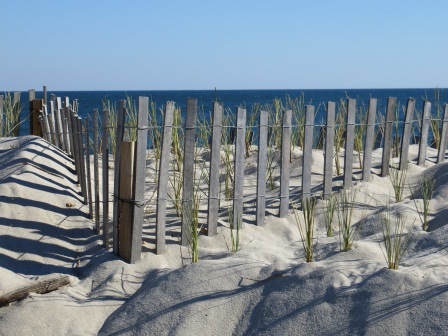Read more about Emma Woods' experience visiting post-Sandy New Jersey.

A trip to post-Sandy New Jersey gets to the nub of what ecosystems can do to reduce risk (perhaps little on their own), and what we mean by resilience (bouncing forward as well as back).
In the wake of Typhoon Haiyan, and having just marked the one-year anniversary of Superstorm Sandy, climatic extremes have certainly been at the forefront of the public and political psyche. With this in mind, my recent visit to New Jersey’s Northern Barrier Island came at a particularly poignant time. It was an eye-opening experience, which made me question both the value of ecosystem-based approaches and the meaning of (desirable) resilience when it comes to coping with extreme weather events.
My hosts were members of the Surfrider Foundation (Jersey Shore Chapter) who had organised a community grass planting event on the sand dunes of Seaside Park. The approach in this stretch of the barrier island has been to erect wood-slatted storm fences on the dunes and to plant beach grass to anchor the sand in place – the rationale being that a robust dune system helps dampen the impact of storm surges.
A morning spent with my knees in the sand, planting grass at carefully measured intervals and depths, and chatting to local residents about their experiences of Sandy certainly felt like an important contribution; a step (however small) towards some sort of resilience. But the question was: what contribution were my fellow dune planters and I really making?
Sand versus Sandy
Ecosystem-based approaches (like restoring New Jersey’s sand dunes) are often touted as cost-effective ways to reduce the impacts of climate change and climate-related disasters. And here in the Science Policy Centre, we’re looking into the extent to which, and circumstances under which, this is true.
Although it will be several months before we reach any firm conclusions, the lasting impression from my time in New Jersey is that the success of such approaches depends on what they’re designed to provide resilience to: a routine ‘nor’easter’ or Superstorm Sandy. Let’s not forget the magnitude of the storm that flattened entire neighbourhoods, and that (even a year on) is responsible for tens of thousands of New Yorkers and Garden Staters without a place to call home. In the face of such force, what difference could healthy, vegetated dunes really make?
In the case of Sandy, it’s difficult to know. There’s no doubt that robust dune systems correlate with several areas that escaped the worst of Sandy’s wrath. But correlation doesn’t equal causation. And many of the people I spoke to believe that the patchy pattern of destruction up and down the Jersey Shore had more to do with the way in which Sandy hit than with the state of the natural environment.
Better, some suggested, to incorporate ecosystem-based approaches into a wider programme of risk reduction and resilience building – as a small contribution to a much bigger problem.
Re-thinking required
To a large extent, Sandy’s aftermath has been swathed in an air of defiance – of community spirit, of not accepting defeat, of soldiering on to fight another day.
No retreat, Sandy, no surrender.
And to a certain extent this has been a popular approach, with New Jersey Governor Chris Christie winning support on account of his confident and speedy re-building programme. Yet dissenting voices also abound, particularly among the individuals I met on the dunes of Seaside Park. Given the devastation inflicted by Sandy, and given projections of more frequent, more intense storms in the future, many are beginning to question why the barrier islands were developed in the first place and why they should be re-developed now.
The idea of bouncing back to a former state following a shock is an appealing one, and one that dominates many definitions of resilience. But simply bouncing back can prove to be a counterproductive if it risks making people more vulnerable to shocks in the long term. Might resilience be much more about bouncing forward; about the capacity to re-think and transform into a more stable, alternative state?
It’s a controversial argument, and one that the Rethink the Jersey Shore group has waded into with gusto. It’s also one that my colleagues and I will continue to grapple with as part of our Human resilience to climate change and disasters project. #RSresilience
